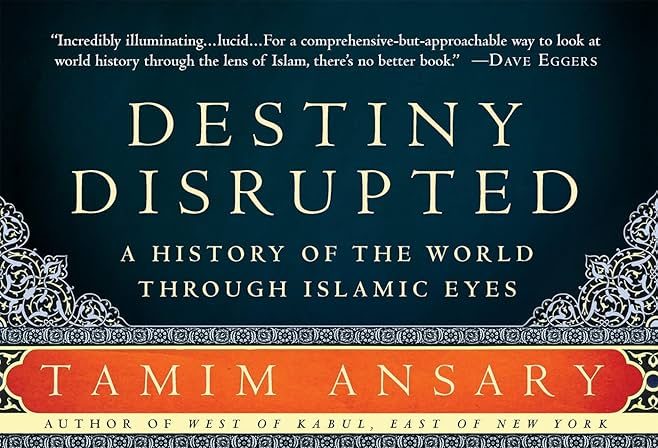“Destiny Disrupted: A History of the World Through Islamic Eyes” by Tamim Ansary is one of my favorite reads this year. It provides an eye-opening experience revealing the common ways the world’s 1.5 billion Muslims view world history.
Ansary, an Afghan native who later migrated to the U.S., offers a unique and necessary perspective on Islamic and world history.
Although he doesn’t claim to be a trained historian, this book’s Islamic bias is an asset that makes reading this book more interesting. Growing up in Afghanistan, Ansary was fascinated by world history but found that mainstream, often European influenced historical accounts largely ignored Islam’s contributions.
This neglect of Islamic history became even more apparent after he moved to the U.S. and worked for a textbook company, where he had to advocate for including Islam, alongside African and pre-Columbian civilizations, in a world history textbook.
Later reflecting on this episode, he wondered: “How, on the eve of 9/11, anyone could have failed to consider Islam a major player at the table of world history! After 9/11, perceptions changed. Non-Muslims in the West began to ask what Islam was all about, who these people were, and what was going on over there.”
As a Jew, I can relate to this marginalization. Western civilization wouldn’t exist without Abraham’s monotheistic revolution and the foundational texts of Judaism which are central to Christianity.
Jewish scholars at the Library of Alexandria compiled the first Greek translation of the Bible which formed the foundations of the Christian religion. The Talmud introduced a complex legal system that laid the groundwork for laws governing damages, marriages, and witnesses.
As the world globalizes it is important to recognize the historical contributions of all cultures to make better decisions in the present.
The most fascinating part of the book was learning Sharia Law and how it works, explained in chapters three and seven.
Sharia law is based on the Hadiths — the sayings and practices of the Prophet Muhammad — recorded later by the Caliph Umar and his scholars and then codified into law.
This was done by collecting Hadiths from those who knew people who knew Muhamad. By sticking to the confines of the Hadiths, new laws were made that were practical for the present needs of an Islamic court.
The Ulama were scholars, who acted like lawyers, who kept these laws in practice and ensured society adhered to the orthodoxy. It is essential to recognize that unlike Roman common law, which is the foundation for most Western countries such as America, this is a divine law, and thus, it is treated as sacred and not to be altered.
Another fascinating thing explored in the book is the sectarianism of Islam and how it came to be.
Chapters three and four tell the story of the Sunni-Shia, a tragic family drama with lasting consequences between Imam Ali and the heirs of Abu Bakr, the first Caliph of Islam.
Both Sunni and Shia believe themselves to be the true successors of the prophet Muhammad and the proper vision of Islam. Many of the wars currently going on in the Middle East, such as in Yemen and Syria are part of a great power game between Sunnis and Shias to be the ideological hegemony of the Islamic world.
Iran has its own “axis of resistance” consisting of Hezbollah, the Syrian Assad Regime, the Houthis, as well as Sunni Hamas. Western-backed Sunni Muslim powers such as Saudi Arabia and the United Arab Emirates seek to contain Iran’s influence by getting involved in civil wars in Yemen, Syria and now Sudan for control over the Islamic world.
Ansary tells the story of Sunnis and Shias in incredibly heartbreaking and emotional prose without ever taking a side and allowing the readers to come to their own conclusions.
The most important aspect of this book for anyone interested in foreign policy or religions is Ansary’s exploration of the reformation, similar to that of Western Christendom, taking place from the decline of the Ottoman Empire to the present day, as explained in chapters 13 and 14. Ansari addresses three reformer ideologies: Wahhabism, Secular Modernism, and Islamist Modernism.
Wahhabism, founded by Arab preacher Muḥammad ibn Abd al-Wahhāb, sought to restore Islam to its most basic form and remove all the “innovations” implemented after the prophet died. Sayyid Ahmad from Aligarh, India, wanted to secularize Islam and change it for modern times. And Sayyid Jamaluddin-i-Afghan, whose birthplace is disputed as either Afghanistan or Iran, sought to blend modern innovations to preserve and strengthen Islam on the world stage.
Ansary believes these Ideas had an ideological basis throughout the Islamic world’s nineteenth and twentieth centuries.
This book provides an insider view of world history through Islamic eyes. This was one of this year’s best reads, if not my favorite. I now feel more confident in my understanding of the Islamic world due to my knowledge of its legal traditions, sectarianism, and political diversity.
Ari Sorokin can be reached at orionmanagingeditor@gmail.com.








